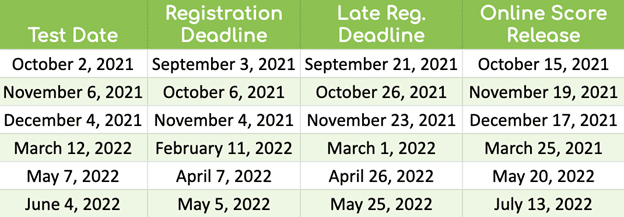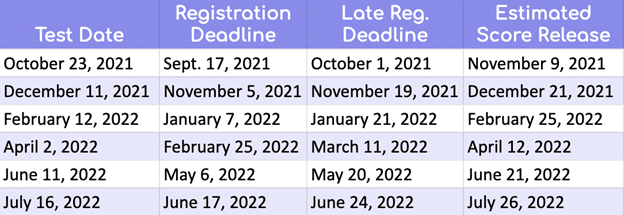Last Updated On: July 1st, 2024
Please note that this information is subjective and does not reflect our position on every student or situation. For more specialized information and advice tailored to your student, please contact our admissions consultants.
Written by Angela B. and Wendy I.
ISEE/SSAT
Inside scoop for ISEE/SSAT:
Standardized testing is becoming less commonplace in middle and high school applications. While this benefits students that may be catching up from online learning loss, the change has also started to create a hole in the process. Some schools have found other holistic ways to evaluate students without a standardized exam. Other schools have already created their own individualized testing in english, math, and writing. Tests like the ISEE and SSAT exist and thrive for this exact reason. If all schools begin to create their own individual entrance exams, students will once again be left with extreme preparation demands, no clarity on what to prepare, and no standardized admissions process.
Test Time!
When is the best time to schedule the test?
If you are taking the ISEE remember that most tend to take this during the fall and winter. Students can only take the ISEE once per season. Since November is part of the “fall season” and December is part of the “winter season” many students prefer to stack their two test dates back to back in these months. (See the chart below for more clarity on this.) This two test approach is great; if students and parents aren’t happy with their October/November fall score, then the student can easily do a bit more test prep work and retake in December before scores and applications are officially due.

For the SSAT, the rules are slightly more flexible. Per testing year, August 1-July 31st, you can take this test up to six times for paper-based testers and three times for prometric or online at-home testers. If you’re still not quite sure what the big differences are between these two tests, start here.
Do schools hold it against you if you test multiple times?
Both tests hold no penalties for students that want to take the test multiple times. Most students take the ISEE and SSAT at least twice. Always opt out of sending the scores directly to the schools before viewing scores. That way you have the option of which scores to send. If your child does better on the second round of testing, you only have to send the second set and none of your schools need to know about that first nerve-wracking experience.
Should you test for test optional schools?
This is the biggest question on everyone’s mind. If you plan to apply to a rigorous academic school that has taken a test optional policy, be wary that they may hold bias if you don’t sit for the exam. While the admissions team can’t legally hold your choice to opt-out against you, it does show them that you already didn’t want to go the extra mile to prepare and test. All this being said, know the school and then make an informed decision. Is this a more creative school? Do they place a great deal of importance on testing?
Bottom line, I always recommend testing. The worst case scenario is that you do poorly on the test and don’t end up using the scores because they’re not competitive enough. Why wouldn’t you want to test? In a test optional landscape, taking the extra time and dedication to devote yourself to a standardized test shows you’re not only prepared for the rigor of a private school, but that you’re a good test taker and you will improve their school’s scores. See some of the most sought after private schools according to ERB’s premiere test preparation website.
However, at the end of the day it is your choice. If your child presents a competitive application, essay, interview, and excellent grades then you have the option. While most tutors and admissions consultants would tell you to start with a diagnostic test and decide from there, it is 100% the choice of the parents and student. Read more about test optional and how to choose.
How long should you test prep?
As long as possible. For ISEE and SSAT tests, most mathematics and verbal sections are about one to three grade levels above what the student already knows. The reading is usually very challenging unless your child is an avid speed reader. To add, most of the essays require structure and content that students aren’t yet familiar with. Students can be especially terrified of the timer, so even the writing section requires attention.
If you know your child has a busy summer ahead, start early. If you want to reduce the workload during the school year, start early. Most parents assume a few months should do it, but I’ve seen students prep at a slower pace for a year. In order to avoid burnout, it’s a great practice to give your child 6 months-1 year of prep time. If you don’t have the luxury of doing that, it’s important for the student to have an excellent work ethic and stay motivated throughout the preparation window.
Best practice for students with less than 6 months of prep time would be to meet 2 times per week for at least 1.5-2 hours. Reviewing homework will always take 30-45 minutes so it’s crucial to remember that when scheduling.
How much can you expect your scores to increase with ____ hours of prep?
This is a question that parents love to ask and tutoring companies love to dodge. Why? Because we really can’t tell you. It is all very dependent on the student. If their initial scores are 1s and 2s, it is guaranteed that their scores will sky rocket with sufficient prep. If they walk in with 6s, it’s much harder to get them to jump to 9s. This is because the jump from a 6 to an 8 is not very far. If you need 5 more correct answers to get from a 6 to an 8, you might continue to be stuck in a 7 because you can’t get that 5th question. That doesn’t mean that you’re doomed though. With enough homework preparation, timed exercise work, and committed tutoring time, I have seen students excel further than I imagined possible.
ACT/SAT
Inside scoop for SAT/ACT:
There are so many questions around college admissions tests. The SAT and ACT are mysterious components of the college application packet. While there are many more questions about these tests than can be answered in any blog, here are some answers to some popular questions.
When is it best to test?
When is the best time to schedule the test?
When you are scheduling an ACT/SAT, consider other obligations:
>>Consider the summer prep time vs. the summer backslide
- If a student is dedicated to preparing during the typically less busy summer, then the August/September dates would be best.
- If a student is unlikely to study during summer or has involved summer obligations, then a spring date would be best, taking advantage of the year’s learning. A December test avoids finals and the end-of-the-year burnout and would work too.
>>April/ May dates are hard for a student with many AP test commitments
- June might not be much better as it does not allow for much preparation before the test, unless the student has many AP classes that stop after the AP tests and that extra time can be applied to SAT/ACT prep.
>>Early Decision deadlines are in early-mid November, so the September/October dates are the absolute last options for perfectionists and procrastinators if you are planning to do Early Decision times. See Early Decision dates here.
- Spring and summer dates are going to be more comfortable times to test for Early Decisions applicants, as the Fall tests are still available as backup dates.
- Early Decision II dates vary a bit more by school, so a student planning to submit for Early Decision II would want to adjust based on those times.
- See below for standard test dates and links to registration


Should you test multiple times? How does that look to schools?
Retesting is normalized, so retesting does not hurt your application, and can show an ability to rededicate and improve. However, the scores must improve to get this benefit. Retesting many times with little improvement will not send the best message to colleges. Knowing whether the colleges being applied to do superscoring or not will influence decisions on how many retests to do and how to distribute time in test prep. In contrast, some colleges require you to send your entire testing history, so a thorough understanding of how a particular school approaches its applicants’ scores is extremely important.
Should I test at all?
Should you test for test optional schools?
If they publish that they are test-blind, then there is no reason to take or submit the test. If test scores are available, consider putting that the test scores are available if desired, but if they have stated they are test-blind, then their policy is not to look at or consider tests. If the college is test optional, consider whether the application has any weaknesses that might be bolstered with a solid test score. Also realistically consider the time available for preparation towards the type of score that would benefit an application. A solid test score can do great things for an application that is weak in other areas if the time is dedicated to building a solid SAT or ACT score.
What will matter most if you don’t test?
The question of making up for standardized test scores in an application is fantastic and will be answered in the next blog.
How Should I Plan Test Prep?
How many months in advance is best for prep?
Preparation for standardized tests is like any other preparation in that more is better unless the student burns out or loses motivation and focus. A guided test prep program can address individual needs in a varied way that can make for productive work that will benefit test scores and all the relevant test-taking skills for years. However, students have different levels of endurance for study.
A good plan is to begin preparation as soon as possible and start at a more intense level. If the student reaches the goal score, most often determined by the admissions information of the student’s schools with some additional points added as a buffer, then the program can ease back to a maintenance-level frequency.
How much can you expect your scores to increase with ____ hours of prep?
Despite the desire to definitively quantify a timeline for a set amount of improvement, this question and the closely related “How much time do you need to increase your score ____ points” cannot be answered in advance. Score improvement depends on application to study and on the number of topics that are being improved. It is also easier to improve a lower score than it is to improve a higher score. New areas of weakness or confusion show up that require longer time, and general concepts, when addressed, can cause great improvement in one swoop. These things cannot be predicted but will only be identified during preparation.
Photo by Yan Krukov from Pexels




















